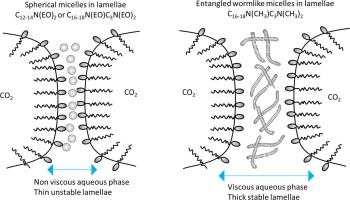Journal of Colloid and Interface Science ( IF 9.4 ) Pub Date : 2018-03-13 , DOI: 10.1016/j.jcis.2018.03.037 Amro S. Elhag , Chang Da , Yunshen Chen , Nayan Mukherjee , Jose A. Noguera , Shehab Alzobaidi , Prathima P. Reddy , Ali M. AlSumaiti , George J. Hirasaki , Sibani L. Biswal , Quoc P. Nguyen , Keith P. Johnston

|
Hypothesis
The viscosity and stability of CO2/water foams at elevated temperature can be increased significantly with highly viscoelastic aqueous lamellae. The slow thinning of these viscoelastic lamellae leads to greater foam stability upon slowing down Ostwald ripening and coalescence. In the aqueous phase, the viscoelasticity may be increased by increasing the surfactant tail length to form more entangled micelles even at high temperatures and salinity.
Experiments
Systematic measurements of the steady state shear viscosity of aqueous solutions of the diamine surfactant (C16-18N(CH3)C3N(CH3)2) were conducted at varying surfactant concentrations and salinity to determine the parameters for formation of entangled wormlike micelles. The apparent viscosity and stability of CO2/water foams were compared for systems with viscoelastic entangled micellar aqueous phases relative to those with much less viscous spherical micelles.
Findings
We demonstrated for the first time stable CO2/water foams at temperatures up to 120 °C and CO2 volumetric fractions up to 0.98 with a single diamine surfactant, C16-18N(CH3)C3N(CH3)2. The foam stability was increased by increasing the packing parameter of the surfactant with a long tail and methyl substitution on the amine to form entangled viscoelastic wormlike micelles in the aqueous phase. The foam was more viscous and stable compared to foams with spherical micelles in the aqueous lamellae as seen with C12-14N(EO)2 and C16-18N(EO)C3N(EO)2.
中文翻译:

粘弹性二胺表面活性剂,可在广泛的盐度和温度范围内稳定二氧化碳/水泡沫
假设
使用高粘弹性含水薄片可以显着提高高温下的CO 2 /水泡沫的粘度和稳定性。在减慢奥斯特瓦尔德熟化和聚结时,这些粘弹性薄片的缓慢变薄导致更大的泡沫稳定性。在水相中,即使在高温和高盐度下,可以通过增加表面活性剂的尾部长度以形成更多的缠结胶束来增加粘弹性。
实验
在不同的表面活性剂浓度和盐度下,对二胺表面活性剂(C 16-18 N(CH 3)C 3 N(CH 3)2)水溶液的稳态剪切粘度进行了系统测量,以确定缠结的形成参数蠕虫状的胶束。比较了具有粘弹性纠缠的胶束水相的系统与具有更少的粘性球形胶束的系统相比,CO 2 /水泡沫的表观粘度和稳定性。
发现
我们首次证明了使用单一的二胺表面活性剂C 16-18 N(CH 3)C 3 N(CH 3)2可以在高达120°C的温度下稳定的CO 2 /水泡沫和高达0.98的CO 2体积分数。。通过增加具有长尾巴和胺上的甲基取代的表面活性剂的填充参数来增加泡沫稳定性,从而在水相中形成缠结的粘弹性蠕虫状胶束。与C 12-14 N(EO)2和C 16-18 N(EO)C 3 N(EO)2相比,该泡沫与水性薄片中具有球形胶束的泡沫相比,更粘且稳定。。











































 京公网安备 11010802027423号
京公网安备 11010802027423号